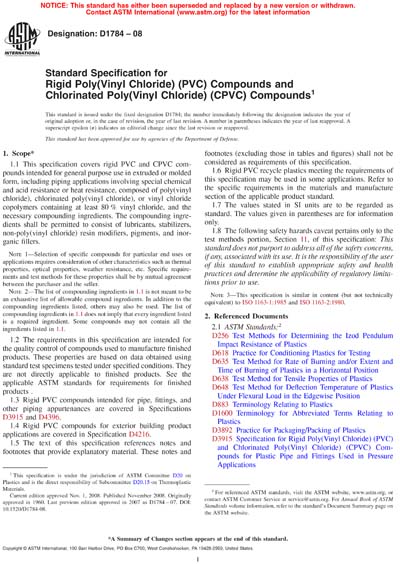Historical
ASTM D1784-08
Standard Specification for Rigid Poly(Vinyl Chloride) (PVC) Compounds and Chlorinated Poly(Vinyl Chloride) (CPVC) Compounds
1.1 This specification covers rigid PVC and CPVC compounds intended for general purpose use in extruded or molded form, including piping applications involving special chemical and acid resistance or heat resistance, composed of poly(vinyl chloride), chlorinated poly(vinyl chloride), or vinyl chloride copolymers containing at least 80 % vinyl chloride, and the necessary compounding ingredients. The compounding ingredients shall be permitted to consist of lubricants, stabilizers, non-poly(vinyl chloride) resin modifiers, pigments, and inorganic fillers.
Note 1—Selection of specific compounds for particular end uses or applications requires consideration of other characteristics such as thermal properties, optical properties, weather resistance, etc. Specific requirements and test methods for these properties shall be by mutual agreement between the purchaser and the seller.
Note 2—The list of compounding ingredients in 1.1 is not meant to be an exhaustive list of allowable compound ingredients. In addition to the compounding ingredients listed, others may also be used. The list of compounding ingredients in 1.1 does not imply that every ingredient listed is a required ingredient. Some compounds may not contain all the ingredients listed in 1.1.
1.2 The requirements in this specification are intended for the quality control of compounds used to manufacture finished products. These properties are based on data obtained using standard test specimens tested under specified conditions. They are not directly applicable to finished products. See the applicable ASTM standards for requirements for finished products .
1.3 Rigid PVC compounds intended for pipe, fittings, and other piping appurtenances are covered in Specifications D 3915 and D 4396
1.4 Rigid PVC compounds for exterior building product applications are covered in Specification D 4216
1.5 The text of this specification references notes and footnotes that provide explanatory material. These notes and footnotes (excluding those in tables and figures) shall not be considered as requirements of this specification.
1.6 Rigid PVC recycle plastics meeting the requirements of this specification may be used in some applications. Refer to the specific requirements in the materials and manufacture section of the applicable product standard.
1.7 The values stated in SI units are to be regarded as standard. The values given in parentheses are for information only.
1.8 The following safety hazards caveat pertains only to the test methods portion, Section 11, of this specification: This standard does not purport to address all of the safety concerns, if any, associated with its use. It is the responsibility of the user of this standard to establish appropriate safety and health practices and determine the applicability of regulatory limitations prior to use. Note 3—This specification is similar in content (but not technically equivalent) to ISO 1163-1:1985 and ISO 1163-2:1980.
Content Provider
ASTM International [astm]






